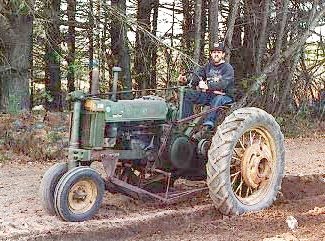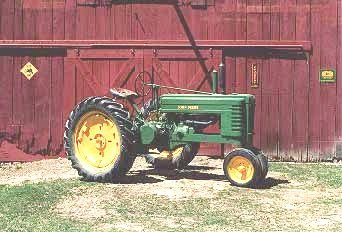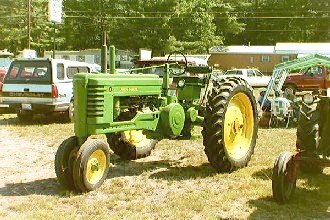
 The Model B was introduced late in 1934 as a 1935 model. It was a
medium sized tractor, capable of pulling a plow with two twelve inch bottoms.
As standard equipment, it had steel wheels, four speeds forward and one reverse,
and had a belt pulley and a PTO
(The Power Take Off, a splined shaft at the rear of the tractor
for powering implements)
A hydraulic powerlift was available as an option, as
were rubber tires on either the front, the back, or both.
The first illustration shows the tractor as it was produced from 1935 to 1938.
This is what is known as "unstyled". There are no grills or other sheetmetal
covering the radiator. The first 2000 tractors built had a "four bolt" front
pedestal. The steering post in front of the radiator was bolted to the frame
with just four bolts instead of the eventual eight.
These tractors are extremely desirable. The 1935 Model B's are
called "Brass Tag" because they have a brass serial number plate. In late
1937 the front frame was lengthened so that the Model B could
share some integral implements with the Model A. From this point on, the tractors were
referred to as "Long Frame" as opposed to the previous "Short Frame". All
of the John Deere two cylinder tractors at this time were designed to run
on "tractor fuel" or "distillate". This was less volatile than gasoline, so
the tractors had a small gasoline tank located behind the main fuel tank,
for starting the engine. Then, when the engine was warmed up, a "three-way-valve"
in the fuel line could be switched, and the tractor would run on the heavier
fuel in the main tank. This early Model B weighed about 2700 lbs. Horsepower
figures are debatable, but the engine had a displacement of 149 cubic inches.
Approximately 57,000 of these tractors were built from 1934 to 1938.
The Model B was introduced late in 1934 as a 1935 model. It was a
medium sized tractor, capable of pulling a plow with two twelve inch bottoms.
As standard equipment, it had steel wheels, four speeds forward and one reverse,
and had a belt pulley and a PTO
(The Power Take Off, a splined shaft at the rear of the tractor
for powering implements)
A hydraulic powerlift was available as an option, as
were rubber tires on either the front, the back, or both.
The first illustration shows the tractor as it was produced from 1935 to 1938.
This is what is known as "unstyled". There are no grills or other sheetmetal
covering the radiator. The first 2000 tractors built had a "four bolt" front
pedestal. The steering post in front of the radiator was bolted to the frame
with just four bolts instead of the eventual eight.
These tractors are extremely desirable. The 1935 Model B's are
called "Brass Tag" because they have a brass serial number plate. In late
1937 the front frame was lengthened so that the Model B could
share some integral implements with the Model A. From this point on, the tractors were
referred to as "Long Frame" as opposed to the previous "Short Frame". All
of the John Deere two cylinder tractors at this time were designed to run
on "tractor fuel" or "distillate". This was less volatile than gasoline, so
the tractors had a small gasoline tank located behind the main fuel tank,
for starting the engine. Then, when the engine was warmed up, a "three-way-valve"
in the fuel line could be switched, and the tractor would run on the heavier
fuel in the main tank. This early Model B weighed about 2700 lbs. Horsepower
figures are debatable, but the engine had a displacement of 149 cubic inches.
Approximately 57,000 of these tractors were built from 1934 to 1938.

 By 1939 automobiles had become streamlined; and tractors had
to be modernized as well. The tractor was redesigned by Henry Dreyfuss.
Grills were added in front of the radiator and the sheet metal
became "styled".
The engine was enlarged to 175 cubic inches at this time. The weight
increased to over 3000 lbs. Electric starting and lights
became available as an option. A tractor with electric start in 1939 and
1940 is known as a "Slant Dash" due to the shape of its dashboard. The
battery was located behind the fuel tanks and in front of the new, freestanding
dashboard. It was covered with sheetmetal panels that were shaped to
match the hood. These early electric-start tractors were sometimes
called "Long Hood".
In 1941 the engine was changed again slightly, and the transmission
was modified to include six forward speeds. Beginning at this point, all
of the electric-start tractors had the more familiar "Straight Dash".
Several other small changes were made between 1941 and 1947, among them:
The PTO shaft was increased in diameter to 1 3/8", the drawbar was changed
to a much stronger arrangement, and the front frame was changed from
angle iron to cast iron and back again, due to shortages during the war.
Many tractors were made without starters, lights and rubber tires, for the
same reason. Some were even built with only a four-speed transmission.
About 140,000 of the "Early Styled" Model B tractors were built.
By 1939 automobiles had become streamlined; and tractors had
to be modernized as well. The tractor was redesigned by Henry Dreyfuss.
Grills were added in front of the radiator and the sheet metal
became "styled".
The engine was enlarged to 175 cubic inches at this time. The weight
increased to over 3000 lbs. Electric starting and lights
became available as an option. A tractor with electric start in 1939 and
1940 is known as a "Slant Dash" due to the shape of its dashboard. The
battery was located behind the fuel tanks and in front of the new, freestanding
dashboard. It was covered with sheetmetal panels that were shaped to
match the hood. These early electric-start tractors were sometimes
called "Long Hood".
In 1941 the engine was changed again slightly, and the transmission
was modified to include six forward speeds. Beginning at this point, all
of the electric-start tractors had the more familiar "Straight Dash".
Several other small changes were made between 1941 and 1947, among them:
The PTO shaft was increased in diameter to 1 3/8", the drawbar was changed
to a much stronger arrangement, and the front frame was changed from
angle iron to cast iron and back again, due to shortages during the war.
Many tractors were made without starters, lights and rubber tires, for the
same reason. Some were even built with only a four-speed transmission.
About 140,000 of the "Early Styled" Model B tractors were built.

 The Model B was redesigned again in 1947, and appropriately called the
"Late Styled B" The most significant visual differences
were the pressed steel frame and the cushion seat that now housed the battery box.
The engine was enlarged once again, to 190 cubic inches, and a higher
compression version (for gasoline only) became available. In this option,
the fuel tank was larger and there was no smaller gasoline starting tank.
(And you gained about 3 more horsepower!) The electric
starter was now built into the tractor (underneath) and became standard
equipment. The Model B could now weigh over 4000 lbs., depending
on its equipment. About 110,000 Model B's were built in this style. The Model B
was then replaced, in 1952, by the Model 50, which bore a closer resemblance to the
final Model B's than the first Model B's did!
The Model B was redesigned again in 1947, and appropriately called the
"Late Styled B" The most significant visual differences
were the pressed steel frame and the cushion seat that now housed the battery box.
The engine was enlarged once again, to 190 cubic inches, and a higher
compression version (for gasoline only) became available. In this option,
the fuel tank was larger and there was no smaller gasoline starting tank.
(And you gained about 3 more horsepower!) The electric
starter was now built into the tractor (underneath) and became standard
equipment. The Model B could now weigh over 4000 lbs., depending
on its equipment. About 110,000 Model B's were built in this style. The Model B
was then replaced, in 1952, by the Model 50, which bore a closer resemblance to the
final Model B's than the first Model B's did!
|

